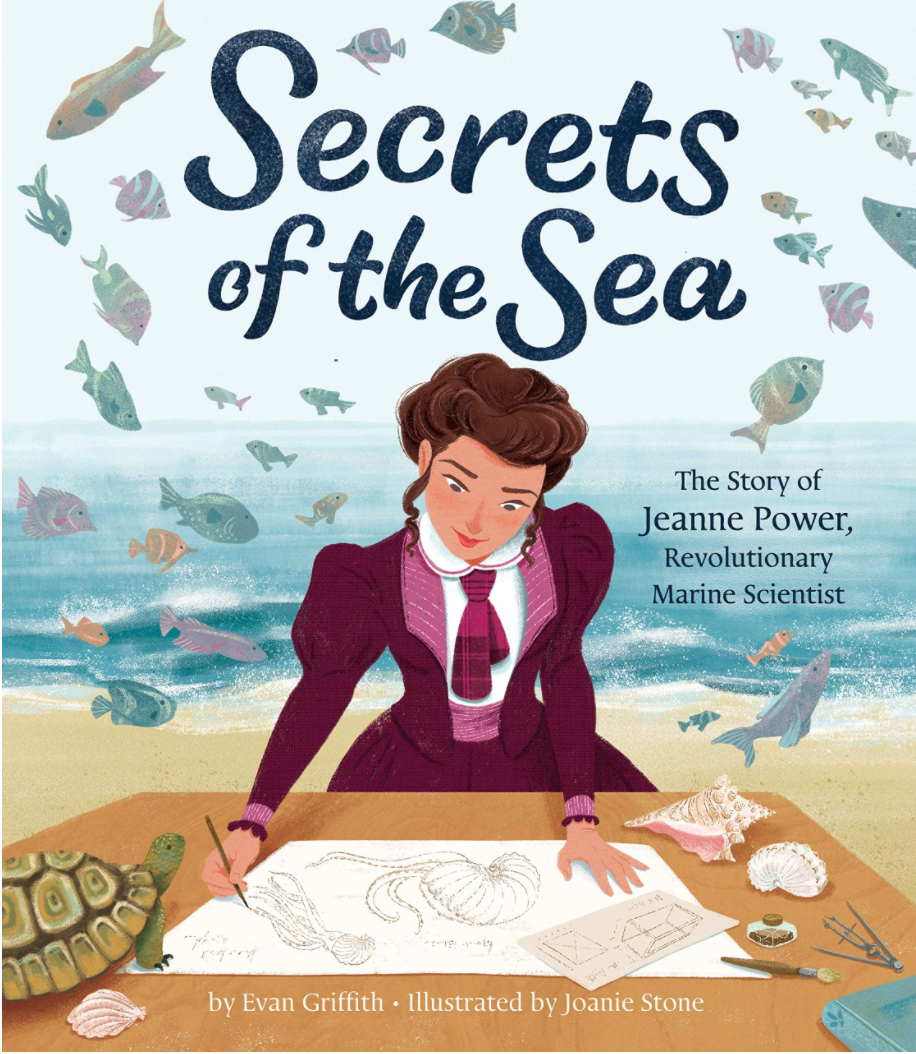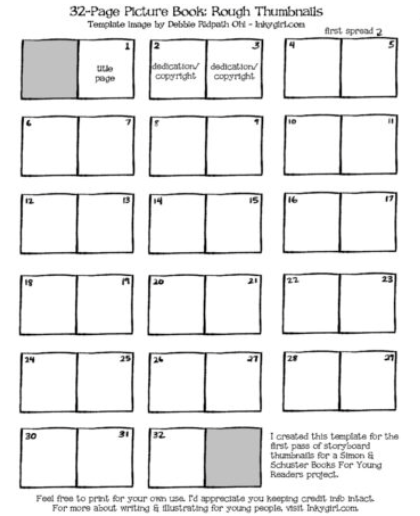craft review by Anne-Marie Strohman
Non-fiction picture books are having a heyday. Biographies, science books, informative texts are an integral part of both classroom reading and home reading. The key feature of non-fiction picture books is engaging readers by shaping the reader experience—helping them know why the information is interesting and keeping them turning pages to see what happens.
The story of Jeanne Powers, a marine biologist who designed the first aquarium and made important discoveries about the paper nautilus octopus, isn’t by necessity an exciting one. She builds a thing and watches animals all day. But as told by Evan Griffith in Secrets of the Sea, it’s an exciting tale. He keeps the story active by providing context to explain how important her work was, providing detailed descriptions and examples to prove his points about Jeanne, and employing effective sentences at the ends of spreads that make readers want to turn the page. In each instance, he sets up expectations, context, or questions that lead readers through a delightful story.
Context
The context Griffith provides helps readers know WHY we should care about Jeanne Powers and why her work was important. On the fourth spread, he gives us the big piece of context we need: “The year was 1818. Women weren’t encouraged to be scientists, but Jeanne didn’t let that stop her.” This information sets up the context for Jeanne’s uphill battle to be recognized for her work.
In the next spread, she thinks about how to see live aquatic animals up close and wants an aquarium, “Jeanne didn’t know where to find such a tank . . .” because they didn’t exist. As the book continues, Griffith highlights the scientific arguments about the paper nautilus and the various attitudes of scientists accepting or doubting her work.
Griffith often uses embedded clauses to indicate the importance of something. Late in the book, we find this sentence: “Jeanne joined many scientific academies throughout her life, a rare feat for a woman in the nineteenth century.” He makes sure readers know that joining academies was important and that as a woman, Jeanne was doing something revolutionary.
Set Up for Specific Details
Specific details can lift a story from ordinary to extraordinary. In his KidLit Craft interview, Griffith said that in particular, he wanted his opening spread to be grounded in specific sensory details to draw readers in. He uses lots of specific details throughout the story, but he also provides context for those specific details by leading in with a general category.
For instance, the third spread has a context followed by specific details:
Jeanne explored the island.
She saw wild olive trees and cypresses swaying in the breeze, falcons and eagles soaring overhead, hares scampering over grassy hills, and porcupines foraging among the bushes.
Sometimes, when she looked out to sea, she caught a glimpse of a breaching whale or a leaping swordfish.
Sicily was buzzing with life.
It gave Jeanne a wild idea.
First we get a category for the coming information: “Jeanne explored the island.” We know what follows will tell us what she found as she explored. That introductory sentence is short and to the point.
After the specific details, Griffith gives a summary statement—what those specifics show us about the island: “Sicily was buzzing with life.” This short sentence also helps readers interpret the details in a way that supports the main themes of the book.
This example adds a kicker sentence at the end that spurs us to turn the page. Readers want to know what wild idea Jeanne had. We can expect what will follow will be the specifics of her wild idea—another set-up sentence.
(Take a look late in the story at the page that begins, “It was never an easy road, but Jeanne stood her ground at every turn,” for another example of this context-details technique.)
Page turns
This “wild idea” page turn sets up a question in readers’ minds: What is Jeanne’s wild idea? They have to turn the page to find out.

Similar to the “she had a wild idea” page turn, in other places Griffith uses contrasts and hints to lead readers to turn the page. On the fourth spread, the last sentence is, “But Jeanne wasn’t content to study only land animals.” The reader asks: What else does she want to study? and they have to turn the page to find out.
A few different places he uses explicit questions—instead of nudging the reader to ask the question, Griffith states it. The second spread ends: “What would she do? Who would she become?” The next spread (and ultimately the whole story) answers these questions. The key to using explicit questions is to make sure they are clear and focused and that you answer them on the following page.
Another page-turn technique Griffith uses is stating a problem to be solved. On the fifth spread, Jeanne wants to study aquatic life up close while it is still alive. She imagines a glass tank, but “Jeanne didn’t know where to find such a tank.” Jeanne has a problem. She has an idea for a thing and she can’t figure out where to get one. Readers turn the page to find out how Jeanne solves this problem. (This specific page turn wouldn’t work if Jeanne’s uncle bought her a tank in Guatemala; it works because Jeanne solves this problem. The focus is on Jeanne and her inventions.)
At times, Griffith also splits a sentence over the page turn, so readers read the first part of the sentence that ends with an ellipsis, then have to turn the page to find out the end of the sentence. For instance, once Jeanne has her aquarium and sea creatures to study, “She pressed her face against the aquarium glass and waited, day after day . . .” We know there is an “until” coming, but we have to wait with Jeanne through the page turn. This strategy gives an extra dose of what some writers call “forward lean,” the anticipation of what comes next.
NOW IT’S YOUR TURN!
Take a look at the last sentence of every spread of Secrets of the Sea. Does the sentence inspire a question, state a problem, or delay a piece of information that readers are dying to know? If not, is there another technique that causes “forward lean”? (You will find a few spreads that have a settled final moment—readers need these too for variety, and they work in context because Griffith has created enough forward lean in the overall story that readers will stay to find out more.)
Make a dummy of your story, and write out the words you think should go on each spread. Examine the page-turns. Do they fit into the above categories? Do you have variety? Try out splitting up the text differently, and/or try out different kinds of page turns.
Analyze your picture book draft. In sections with specific details, mark the details with one color highlighter and mark set-up sentences with another. Not every set of details needs a set-up sentence, but examine each to see if it would be better off with one. Perhaps even try it out to see what the impact is.
Read through your draft and highlight any time you provide contextual interpretation for your readers—any points that you say, “this is a big deal because . . .” If important moments of the story don’t have context set-up, try adding it and see what happens.
Remember: you can always change your story back to what you had before. (Save a version to be sure.) Chances are, you’ll find something in your experimenting that makes your story better—or it will confirm that what you had already was the right move. So be creative, take some risks, and try a lot of options. Play around! Your story will be better for it.
For more on using significant details, read Significant Detail in Louisiana’s Way Home by Kate DiCamillo by Lindsay Lackey.
For when to choose specific words and when to choose general ones, check out Choosing the Right Words: Emily’s Idea by Christine Evans.
Anne-Marie Strohman (co-editor) writes picture books, middle grade novels, and young adult short stories and novels. She is trained as a teacher, an editor, and a scholar, specializing in Renaissance Literature. She holds an MFA in Writing for Children and Young Adults from Vermont College of Fine Arts and is an active member of SCBWI. Find her at amstrohman.com and on Twitter @amstrwriter.



COMMENTs:
0